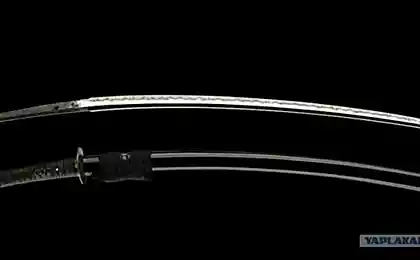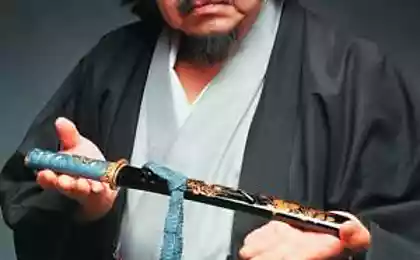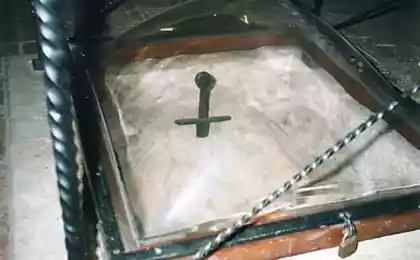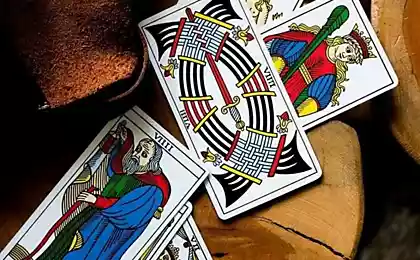1071
12 most famous swords
The sword has always been a weapon of the nobility. The Knights took their blades, as a comrade, and, having lost his sword in battle, the warrior covered disgrace himself. Among the famous representatives of this type of bladed weapons has its own "know" - the famous blades, which, according to legend, have magical properties, for example, put to flight the enemy and protect his master. In these stories there is some truth - artifact sword one of its kind could encourage supporters of its owner. 12 Here is the most famous in the history of deadly relics.
12 photos from here

1. The Sword in the Stone
Many remember the legend of King Arthur, tells the story of how he plunged his sword in the stone to prove his right to the throne. Despite the perfect fantastic story, it may based on real events that occurred only much later alleged reign of the legendary king of the Britons.
The Italian chapel of Monte Siepi is kept firmly entrenched with a lump in her sword, which, according to some, belonged to the knight Galgano Guidotti Tuscan, who lived in XII-th century.
According to legend, Guidotti different nasty temper and led a fairly dissolute life, so one day it was the archangel Michael, and urged him to take the path of service to the Lord, that is, to go to the monks. Laughing, Knight said that he leave the monastery will be as hard as cut stone, and to confirm his words, he slammed the blade lying nearby boulder. Archangel revealed stubborn miracle - the blade is easily entered into the stone, and the affected Galliano and left it there, and then embarked on the road to reform and was later canonized, and the fame of his sword pierced stone, spread throughout Europe.
Subjecting a block and a sword radiocarbon analysis at the University of Pavia, Luigi Garlaskelli found that some part of the story may well be true: the age of the stone and the sword has about eight centuries, that is equal to the lifetime lord Guidotti.
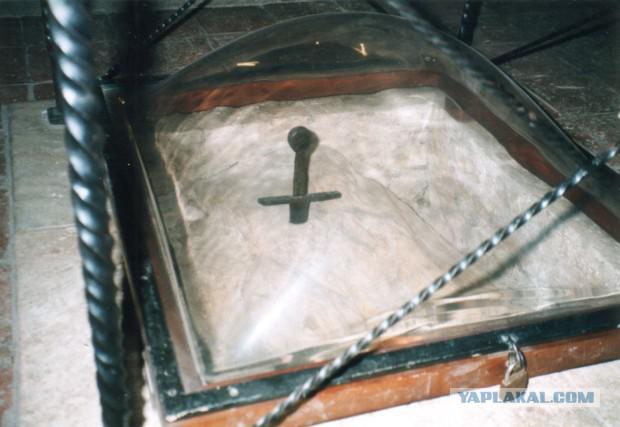
2. Kusanagi
This mythical sword for centuries a symbol of the power of the Japanese emperor. Kusanagi (in the lane. With Jap. - "Sword grass being cleared") is also known as Ame-no-nomurakumo Tsuruga - "sword gathering clouds of heaven».
Japanese epic states that the sword was found the wind god Susanoo in the body of the murdered them vosmigolovogo dragon. Susanoo gave blade sister, the sun goddess Amaterasu, later, he was at her grandson Ninigi, and after a while came to the demigod Jimmu, who later became the first emperor of Japan.
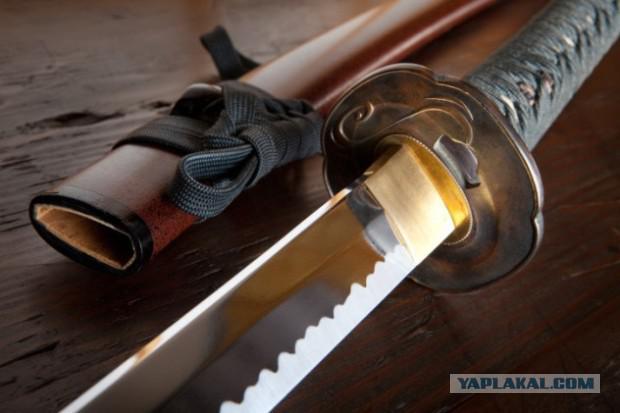
3. Durandal
For centuries, the parish chapel of the Notes Dame, situated in the town of Rocamadour could see stuck in the wall of the sword that is said to have belonged to Roland - the hero of medieval epics and legends that exist in reality.
According to legend, he threw his magic sword, protecting the chapel of the enemy, and the sword was left in the wall. Attracted by these tales of monks in Rocamadour pulled numerous pilgrims who retold the story of the sword Roland each other, and thus the legend spread throughout Europe.
However, according to scientists, in the chapel of the sword is not the legendary Durandal, Roland which terrified his enemies. The famous knight of Charlemagne died 15 August 778, the year in a battle with the Basques in Ronsevalskom Gorge, located hundreds of kilometers from Rocamadour and rumors "Durandal" entrenched in the wall began to emerge only in the middle of the XII-th century, almost simultaneously with the writing "Song of Roland". The monks simply contact name Roland with the sword, to secure a steady stream of worshipers. But rejecting the version of Roland as the owner of the blade, the experts have nothing to offer in return - to whom it belonged, probably will remain a mystery.
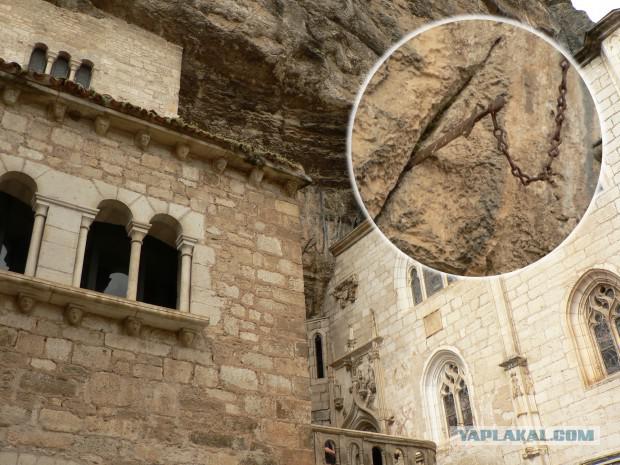
4. Bloodthirsty Blades Muramasa
Muramasa - famous Japanese swordsman and blacksmith, who lived in the XVI-th century. According to legend, Muramasa prayed to the gods, so that they gave his swords bloody and destructive force. Master did a very good sword, and the gods respecting his request by placing every blade demonic spirit of destruction of all living things.
It is believed that if the sword Muramasa long gathering dust around, it can cause the owner to murder or suicide as a way "to get drunk" blood. There are countless stories of holders of Swords Muramasa, who have gone mad or killed many people. After a series of accidents and murders that have occurred in the family of the famous Shogun Tokugawa Ieyasu, the popular rumor that the curse associated with Muramasa, the government declared an outlaw swords masters, and most of them were destroyed.
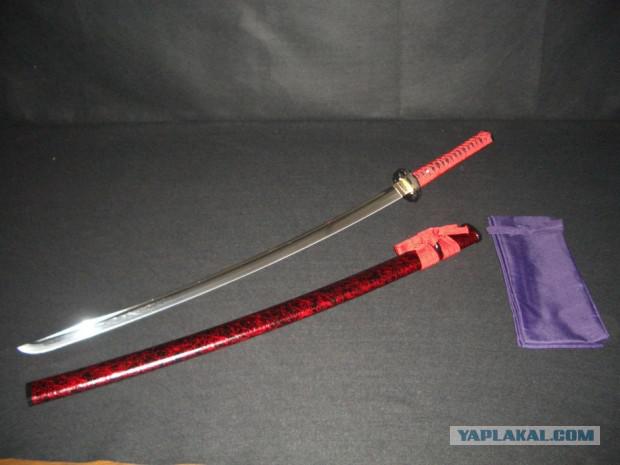
5. Honjo Masamune
In contrast to the bloodthirsty Muramasa swords, blades, made master Masamune, according to legend, warriors endowed with wisdom and serenity. According to legend, to find out whose blades are better and sharper, Muramasa and Masamune lowered his sword into the river lotus. Flowers reveal the essence of each of the masters: the blade of the sword Masamune did not cause them any single scratch, because his blades can not cause harm to an innocent and product Muramasa, on the contrary, if itself has sought to cut the flowers into small pieces, justifying its reputation.
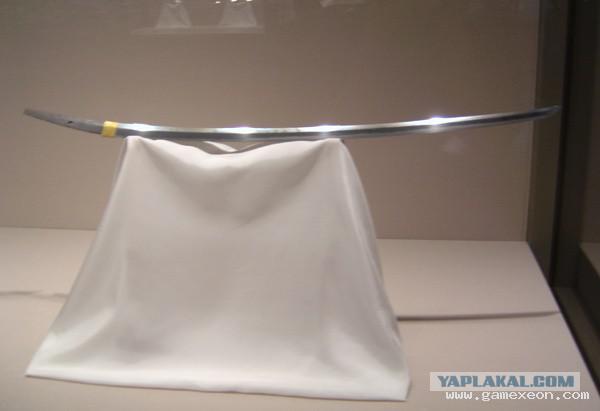
6. Zhuayёz
Blade Zhuayёz (in the lane. With the French. «Joyeuse» - «joyful"), according to legend, he belonged to the founder of the Holy Roman Empire of Charlemagne, and for many years served him faithfully. According to legend, he was able to 30 times a day to change the color and brightness of its blade eclipsed sun. Currently, there are two blades that could wield the famous monarch.
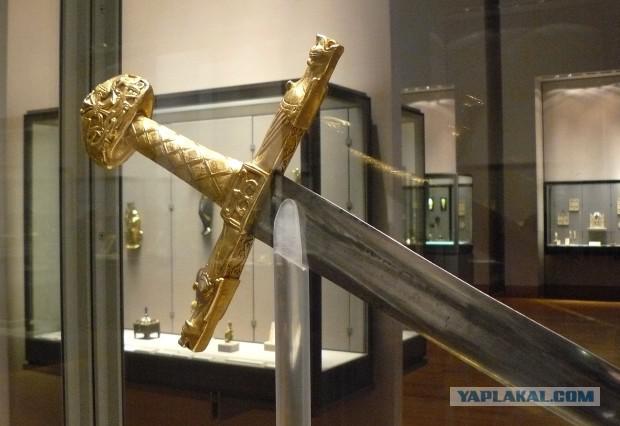
7. Sword St. Peter
There is a legend that the blade, which is part of the museum of the Polish city of Poznan - nothing less than the sword, which the apostle Peter cut off the ear of the servant of the high priest during the arrest of Jesus in the Garden of Gethsemane. The sword in the year 968 brought to Poland, Bishop Jordan, who all insisted that the blade belonged to Peter. Proponents of this myth is believed that the sword was forged at the beginning of the I-st century, somewhere on the eastern outskirts of the Roman Empire
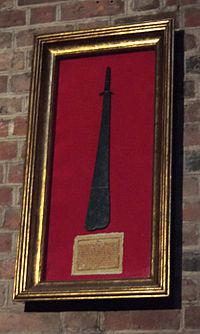
8. Wallace Sword
According to legend, Sir William Wallace, commander and leader of the Scots in the fight for independence from England, after the victory at the Battle of Stirling Bridge obtyanuli the hilt of his sword skin Treasurer Hugh de Kressingema involved in the collection of taxes for the British. Presumably, the unfortunate treasurer had to endure before his death many dreadful moments, because in addition to the hilt Wallace made from the same material as the sheath and sword belt.
According to another version of the legend, Wallace made the leather only sword belt, but to say anything for sure right now is extremely difficult, because at the request of King James IV of Scotland sword underwent alteration - the old worn-out finish of the sword has been replaced by a more befitting this great artifact.
Perhaps, Sir William could actually decorate their weapons treasurer skin: as a patriot of his country, he hated traitors collaborating with the occupiers. But there is another opinion - many people believe that the story was invented by the British to create a fighter for the independence of Scotland image of a bloodthirsty monster. Truth we will likely never know.
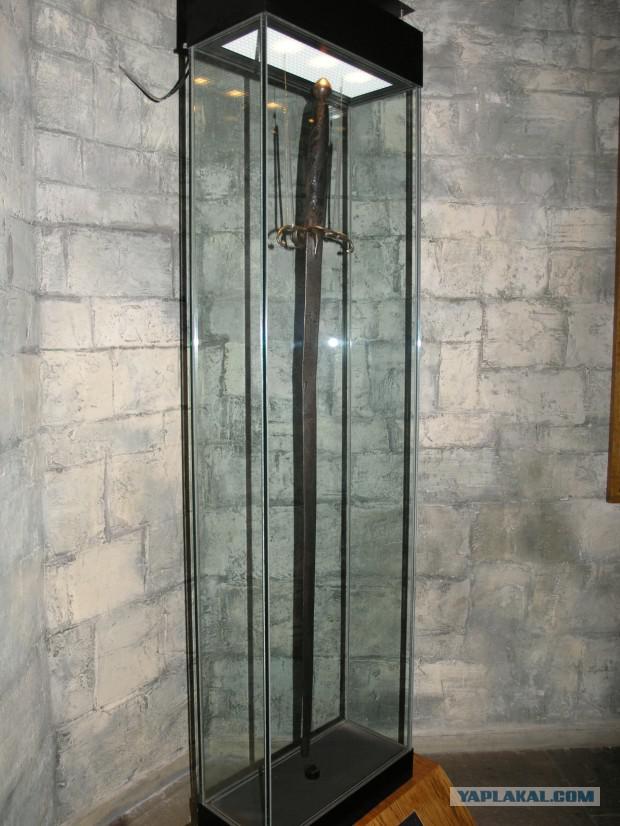
9. Sword Goutszyanya
In 1965, in one of the ancient Chinese tombs, archaeologists found a sword, which, despite the dampness around him for many years, there was not a speck of rust - the weapon was in excellent condition, one of the scientists even cut his finger when checking sharpness blade. Having carefully studied the find, experts were surprised to have stated that it is not less than 2, 5 thousand years.
According to the most common version, the sword belonged Goutszyanyu - one of the Vanir (rulers) of the kingdom of Yue during Vёsen and autumn. Researchers believe that this blade was mentioned in a lost work on the history of the kingdom. According to one legend, the sword Goutszyan considered only worthwhile weapon in his collection, and another legend says that the sword is so beautiful that I could only be created by joint efforts of Heaven and Earth.
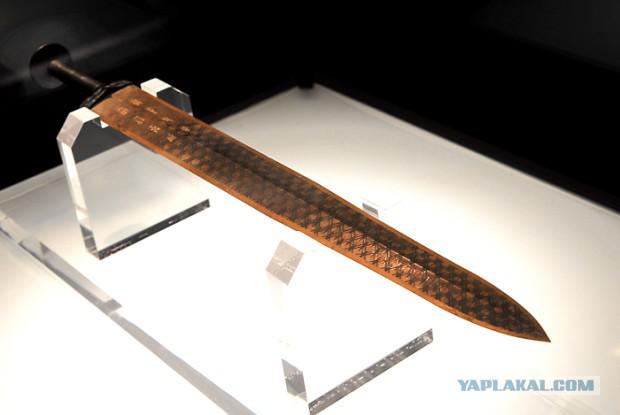
10. Semizuby sword
This extraordinarily beautiful blade was found in 1945 in a Shinto shrine Isonokami Shrine (Japanese city of Tenri). The sword is very different from the usual for us a cold steel of shit Rising Sun, first of all, a complex form of the blade - on it there are six bizarre offshoots, and the seventh is obviously considered the tip of the blade - so found the weapon was named Nanatsusaya-no-tachi (in the lane . with Jap. - "Semizuby sword").
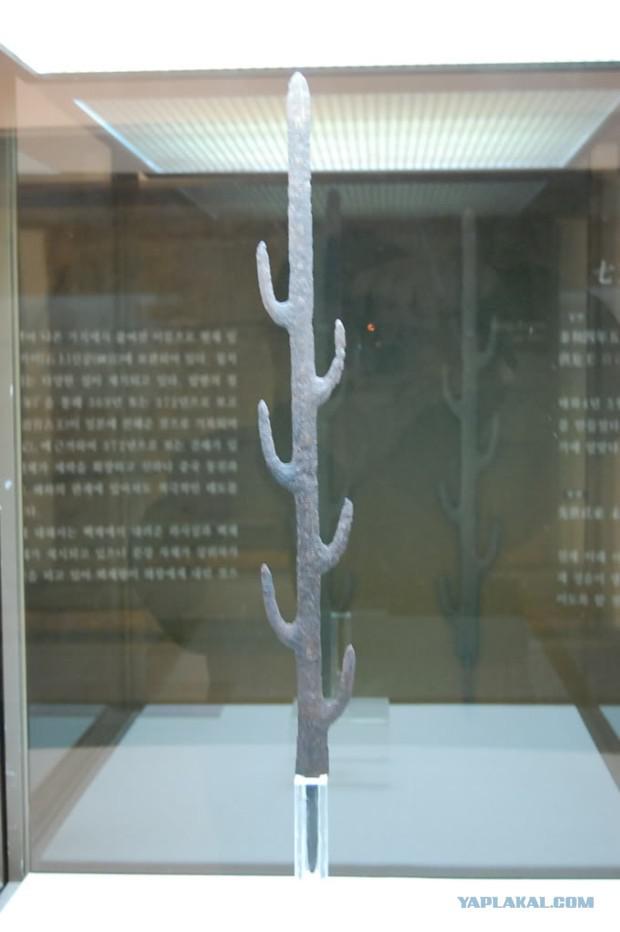
11. Tyson
Weapons that belonged to the legendary Spanish hero Rodrigo Diaz de Vivar, better known as El El Cid, is today in the cathedral city of Burgos and is considered a national treasure of Spain.
After the death of Sid's gun fell to the ancestors of the Spanish King Ferdinand II of Aragon, and inherited his king gave relic Marquis de Falsesu. The descendants of the Marquis of hundreds of years of treasured artifact, and in 1944 with the authorization sword became a part of the exhibition of the Royal Military Museum in Madrid. In 2007, the owner sold his sword to the authorities of the region of Castile and Leon for $ 2 million, and they handed him over to the cathedral, where he is buried El Cid.
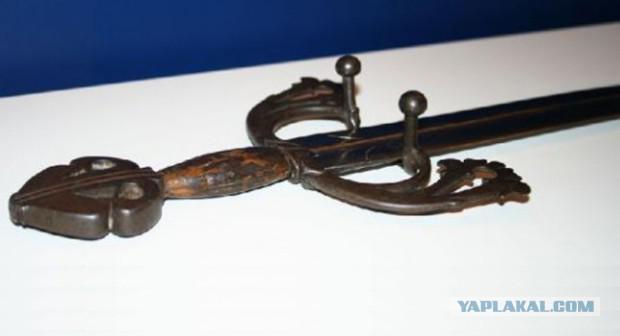
12. Ulfbert
In our time of such swords almost forgotten, but in the Middle Ages the word "ulfbert" enemies of the Vikings experienced genuine horror. Honor possess such weapons belonged exclusively Scandinavian elite armed forces because ulfberty were much stronger than the other swords of the time. Most of the medieval cold steel cast from brittle low-carbon steel with a mixture of slag and the Vikings for their swords bought in Iran and Afghanistan crucible steel, which is much stronger.
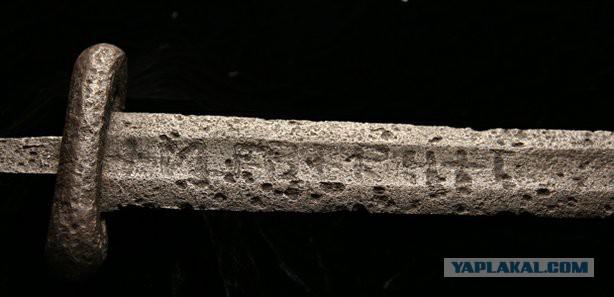
Source:
12 photos from here

1. The Sword in the Stone
Many remember the legend of King Arthur, tells the story of how he plunged his sword in the stone to prove his right to the throne. Despite the perfect fantastic story, it may based on real events that occurred only much later alleged reign of the legendary king of the Britons.
The Italian chapel of Monte Siepi is kept firmly entrenched with a lump in her sword, which, according to some, belonged to the knight Galgano Guidotti Tuscan, who lived in XII-th century.
According to legend, Guidotti different nasty temper and led a fairly dissolute life, so one day it was the archangel Michael, and urged him to take the path of service to the Lord, that is, to go to the monks. Laughing, Knight said that he leave the monastery will be as hard as cut stone, and to confirm his words, he slammed the blade lying nearby boulder. Archangel revealed stubborn miracle - the blade is easily entered into the stone, and the affected Galliano and left it there, and then embarked on the road to reform and was later canonized, and the fame of his sword pierced stone, spread throughout Europe.
Subjecting a block and a sword radiocarbon analysis at the University of Pavia, Luigi Garlaskelli found that some part of the story may well be true: the age of the stone and the sword has about eight centuries, that is equal to the lifetime lord Guidotti.

2. Kusanagi
This mythical sword for centuries a symbol of the power of the Japanese emperor. Kusanagi (in the lane. With Jap. - "Sword grass being cleared") is also known as Ame-no-nomurakumo Tsuruga - "sword gathering clouds of heaven».
Japanese epic states that the sword was found the wind god Susanoo in the body of the murdered them vosmigolovogo dragon. Susanoo gave blade sister, the sun goddess Amaterasu, later, he was at her grandson Ninigi, and after a while came to the demigod Jimmu, who later became the first emperor of Japan.

3. Durandal
For centuries, the parish chapel of the Notes Dame, situated in the town of Rocamadour could see stuck in the wall of the sword that is said to have belonged to Roland - the hero of medieval epics and legends that exist in reality.
According to legend, he threw his magic sword, protecting the chapel of the enemy, and the sword was left in the wall. Attracted by these tales of monks in Rocamadour pulled numerous pilgrims who retold the story of the sword Roland each other, and thus the legend spread throughout Europe.
However, according to scientists, in the chapel of the sword is not the legendary Durandal, Roland which terrified his enemies. The famous knight of Charlemagne died 15 August 778, the year in a battle with the Basques in Ronsevalskom Gorge, located hundreds of kilometers from Rocamadour and rumors "Durandal" entrenched in the wall began to emerge only in the middle of the XII-th century, almost simultaneously with the writing "Song of Roland". The monks simply contact name Roland with the sword, to secure a steady stream of worshipers. But rejecting the version of Roland as the owner of the blade, the experts have nothing to offer in return - to whom it belonged, probably will remain a mystery.

4. Bloodthirsty Blades Muramasa
Muramasa - famous Japanese swordsman and blacksmith, who lived in the XVI-th century. According to legend, Muramasa prayed to the gods, so that they gave his swords bloody and destructive force. Master did a very good sword, and the gods respecting his request by placing every blade demonic spirit of destruction of all living things.
It is believed that if the sword Muramasa long gathering dust around, it can cause the owner to murder or suicide as a way "to get drunk" blood. There are countless stories of holders of Swords Muramasa, who have gone mad or killed many people. After a series of accidents and murders that have occurred in the family of the famous Shogun Tokugawa Ieyasu, the popular rumor that the curse associated with Muramasa, the government declared an outlaw swords masters, and most of them were destroyed.

5. Honjo Masamune
In contrast to the bloodthirsty Muramasa swords, blades, made master Masamune, according to legend, warriors endowed with wisdom and serenity. According to legend, to find out whose blades are better and sharper, Muramasa and Masamune lowered his sword into the river lotus. Flowers reveal the essence of each of the masters: the blade of the sword Masamune did not cause them any single scratch, because his blades can not cause harm to an innocent and product Muramasa, on the contrary, if itself has sought to cut the flowers into small pieces, justifying its reputation.

6. Zhuayёz
Blade Zhuayёz (in the lane. With the French. «Joyeuse» - «joyful"), according to legend, he belonged to the founder of the Holy Roman Empire of Charlemagne, and for many years served him faithfully. According to legend, he was able to 30 times a day to change the color and brightness of its blade eclipsed sun. Currently, there are two blades that could wield the famous monarch.

7. Sword St. Peter
There is a legend that the blade, which is part of the museum of the Polish city of Poznan - nothing less than the sword, which the apostle Peter cut off the ear of the servant of the high priest during the arrest of Jesus in the Garden of Gethsemane. The sword in the year 968 brought to Poland, Bishop Jordan, who all insisted that the blade belonged to Peter. Proponents of this myth is believed that the sword was forged at the beginning of the I-st century, somewhere on the eastern outskirts of the Roman Empire

8. Wallace Sword
According to legend, Sir William Wallace, commander and leader of the Scots in the fight for independence from England, after the victory at the Battle of Stirling Bridge obtyanuli the hilt of his sword skin Treasurer Hugh de Kressingema involved in the collection of taxes for the British. Presumably, the unfortunate treasurer had to endure before his death many dreadful moments, because in addition to the hilt Wallace made from the same material as the sheath and sword belt.
According to another version of the legend, Wallace made the leather only sword belt, but to say anything for sure right now is extremely difficult, because at the request of King James IV of Scotland sword underwent alteration - the old worn-out finish of the sword has been replaced by a more befitting this great artifact.
Perhaps, Sir William could actually decorate their weapons treasurer skin: as a patriot of his country, he hated traitors collaborating with the occupiers. But there is another opinion - many people believe that the story was invented by the British to create a fighter for the independence of Scotland image of a bloodthirsty monster. Truth we will likely never know.

9. Sword Goutszyanya
In 1965, in one of the ancient Chinese tombs, archaeologists found a sword, which, despite the dampness around him for many years, there was not a speck of rust - the weapon was in excellent condition, one of the scientists even cut his finger when checking sharpness blade. Having carefully studied the find, experts were surprised to have stated that it is not less than 2, 5 thousand years.
According to the most common version, the sword belonged Goutszyanyu - one of the Vanir (rulers) of the kingdom of Yue during Vёsen and autumn. Researchers believe that this blade was mentioned in a lost work on the history of the kingdom. According to one legend, the sword Goutszyan considered only worthwhile weapon in his collection, and another legend says that the sword is so beautiful that I could only be created by joint efforts of Heaven and Earth.

10. Semizuby sword
This extraordinarily beautiful blade was found in 1945 in a Shinto shrine Isonokami Shrine (Japanese city of Tenri). The sword is very different from the usual for us a cold steel of shit Rising Sun, first of all, a complex form of the blade - on it there are six bizarre offshoots, and the seventh is obviously considered the tip of the blade - so found the weapon was named Nanatsusaya-no-tachi (in the lane . with Jap. - "Semizuby sword").

11. Tyson
Weapons that belonged to the legendary Spanish hero Rodrigo Diaz de Vivar, better known as El El Cid, is today in the cathedral city of Burgos and is considered a national treasure of Spain.
After the death of Sid's gun fell to the ancestors of the Spanish King Ferdinand II of Aragon, and inherited his king gave relic Marquis de Falsesu. The descendants of the Marquis of hundreds of years of treasured artifact, and in 1944 with the authorization sword became a part of the exhibition of the Royal Military Museum in Madrid. In 2007, the owner sold his sword to the authorities of the region of Castile and Leon for $ 2 million, and they handed him over to the cathedral, where he is buried El Cid.

12. Ulfbert
In our time of such swords almost forgotten, but in the Middle Ages the word "ulfbert" enemies of the Vikings experienced genuine horror. Honor possess such weapons belonged exclusively Scandinavian elite armed forces because ulfberty were much stronger than the other swords of the time. Most of the medieval cold steel cast from brittle low-carbon steel with a mixture of slag and the Vikings for their swords bought in Iran and Afghanistan crucible steel, which is much stronger.

Source:


